Egypt and the Semites Part I: The Pre-Dynastic Period
Fact Paper 10-I
© Samuel Kurinsky, all rights reserved

- Myths, Mysteries and Misconceptions
- Egypt's Prehistoric Period
- Merimde beni-Salame
- The Fayoum Basin
- El Omari; The Asiatics Move Upstream
- Ma'adi: Industrial and Trade Center
- Impact of Asiatic Culture on Upper Egypt
- Conquest of Lower Egypt
- Early Consensus about the Semitic Foundation of Egyptian Civilization
- Exclusionary Politics and Science
- Notes
Myths, Mysteries and Misconceptions
It would seem from books on Egyptian history that it all began with a legendary "King Scorpion" and the First Egyptian Dynasty. The story usually begins with the ascent of this warlord and his successors up the Nile from the South (Upper Egypt) to conquer the northern region (Lower Egypt), including the river's fecund Delta. Little note is taken of the people who were conquered. It is as though they existed only to make place for the barons of Upper Egypt.
Who were these people?
The dean of Egyptian archaeologists, James Henry Breasted, to whom Egyptology is everlastingly indebted for having spent a lifetime copying and preserving Egyptian inscriptions, wrote of what he had learned about the Pre-Dynastic people of Lower (northern) Egypt. They were Asiatics, he pointed out, Semites who played a critical role in the birth of Egyptian civilization. As far back as 1905 Breasted wrote: "It was chiefly at the two northern corners of the Delta that outside influences and foreign elements, who were always sifting into the Nile valley, gained access to the country... The Semitic immigration from Asia, examples of which are also observable in the historic age, occurred in an epoch that lies below our remotest historical horizon."1
Sir Flinders Petrie, whose status in Egyptology is on a par with that of the great Breasted, was similarly impressed by the extent of Semitic influence he found on his excavations in Egypt. He was convinced of the fundamental Semitic origin of Egyptian civilization.
These archaeological pioneers called attention to the multi- faceted impact of Semitic culture upon Lower Egypt. Agronomic, technological, and philological influences were presented; the similarity of the brick construction of the first pyramids with that of Akkadian ziggurats were emphasized; the introduction from Southwest Asia of copper work, as well as virtually every technological innovation that came into being in Egypt over a period of several millennia were cited as reflections of Mesopotamian culture. The appearance in Egypt of the cylinder seal testified to a burgeoning influx of Mesopotamian traders. They cited pictures of Mediterranean-type boats in a tomb at Hieronkopolis and a Mesopotamian-type carved ivory knife-handle recovered from Jebel el-Arak. The carving depicts a full-bearded man dressed in a long cloak. He is in battle with two lions in a posture indistinguishable from that found in similar scenes on artifacts from Mesopotamia.
Later it became the fashion for many archaeologists to reject out of hand the evidence of these and numerous other examples of seminal Asiatic influence. It was claimed that these and other early diggers in ancient graves, garbage pits, and ruins had been unduly influenced by biblical lore. Certain conclusions of the doughty archaeological trailblazers were indeed found to be faulty. The revisionists promptly "threw the baby out with the bath-water."
How did civilization arise in Egypt? Let us examine the facts that are being shunted aside, facts derived from research done before political considerations brought down a cultural curtain.
Egypt's Prehistoric Period
The area west of the Nile (the Libyan and Nubian deserts) was periodically habitable during the Pluvial period. Various paleolithic cultures succeeded each other over a period of seven hundred thousand years as cycles of moist and arid climates affected the area. At the end of that period an arid phase occurred that created the desert condition as it now exists. Climatic changes after the seventh millennium B.C.E. left Upper Egypt, known as the "Red Land," virtually isolated. The Red Land had no resources to sustain much more than a Neolithic culture. Only the Nile served to link the region to both the peoples to the north and to the south.
During this latter period the Nile served as little more than a passageway for traders from the north to Nubia, which had valuable products to barter. There was habitation at spots along the Nile where the eastern escarpment receded enough to allow the growth of native plants sustained by the yearly flooding of the Nile. A primitive form of harvesting took place in these small tracts of such plants. In the Pre-Dynastic period no system of irrigation yet existed to expand the narrow strip of arable land on the western bank into the desert. The petty lords of these enclaves benefitted to some extent from granting passage rights to the commercial traffic on their way to and from Nubia.
Lower Egypt, however, especially the alluvial Nile Delta area, remained remarkably fertile. It was known as the "Black Land." The Black Land had a different set of disadvantages. It was an extensive region encompassing the wide spread of the many-branched mouth of the Nile. Habitable land extended down the river for some distance to where the desert and the rugged cliffs of the Middle Nile encroached upon the river. The Black Land was a marshy region rich with the silt carried down from the distant mountains of Ethiopia and Central Africa and deposited by the annual floods. It was a fecund area, teeming with birds and animals adapted to the soggy environment.
The Delta was lush with foliage, but a quagmire which dried up sufficiently during a good part of the year to support many thousands of domesticated animals. The area had long served as a vital foraging reserve for the peoples of Southwest Asia. During these dry spells the Asiatics brought herds of cattle and flocks of sheep and goats from their parched pastures across the Sinai sands to graze in the lush land biblically referred to as Goshen.
Such an economy existed long before the time in which Abraham is said to have arrived with his entourage and his animals to await a better season for the completion of his aliya to Canaan. Thus, regardless of whether Abraham's odyssey is accepted as actually true or as a vivid tribal memory, the Bible does accurately reflect the economic reality of the region.
The area was not merely a seasonally pastoral Eden. Hillocks rising from the swampy areas provided islands of permanently dry land on which permanent agricultural settlements were established by the Asiatics. These gezirat (Arabic for "turtlebacks") are sedimentary relics that proliferated in the Delta in the Late Pleistone Age. The limitation of a single gezira was resolved by connecting it to other nearby mounds. A village and its environs usually comprised a number of such consolidated mounds. These settlements were also situated athwart the trade routes. Some were close to a branch of the Nile. Many were placed at the junction of the ancient land routes with one of the waterways. Others were implanted at the junctions of land routes crossing the desert. A few of these routes led across North Africa but they were predominately passageways to and from Asia that converged to pass down along the Nile to Nubia.
Merimde beni-Salame
Such a hillock community was Merimde beni-Salame, situated thirty seven miles northwest of present-day Cairo [map, p. 3]. It was discovered in the winter of 1927-28 by Professor Herrman Junker, director of the Vienna Academy of Natural Science's expedition to Egypt. A large flat area of almost fifty acres rose about two meters over the surrounding plain. It was strategically placed between the remaining semiarid pasture-lands of the encroaching desert and the rich alluvial bottomland. It is one of the earliest known farming villages in Lower Egypt, having been settled around 4880 B.C.E. and remaining occupied thereafter for approximately 650 years.
An astounding population of from five to sixteen thousand was projected from the great number of houses identified. The latter figure may be a cumulative one based on dwellings over a period of time. In any event, it is evident that, more than a thousand years before the purported invasion of the Scorpion King, a sizeable, productive, and culturally advanced Asiatic community already had been thriving on the mounds for more than six centuries.
It was immediately clear to the excavators that the Merimdens were radically different from the peoples of Upper Egypt in every respect - physically, culturally, and technologically. Their burial customs were similar to those of the southwestern, Semitic-type Asians, and strikingly different from those of all the Africans. Whereas the African tradition was to bury the dead with a variety of earthly goods to sustain them in the afterlife, and with amulets to protect them from malevolent spirits, the graves of the Merimdens contained no grave offerings of any kind.
Throughout the village clusters of baskets or jars serving as granaries were buried up to their necks in the ground, Circular, clay-lined threshing floors also seemed to be associated with individual dwellings. The Merimdens clearly lived in more or less economically independent single family units, the foundation of the same type of patriarchal system being formed at the time in the Semitic cultures of southwestern Asia. They contrasted sharply with the autarchic systems being generated in Upper Egypt.
[Merimbe] shows none of the distinctively Egyptian characteristics... In its general aspects, Merimde seems more like a village of sturdy yeoman farmers than a collection of peasants subject to the whims, avarice, and authority of a powerful man or a government, although some cooperative efforts (if not collectivization of food-producing tasks) are recalled by the threshing floors up to 13 feet in diameter.2
Merimde's pottery, while technically advanced for its time, was plain and practical, "a theme which sets apart this and later Delta sites from the ornament-ridden and display-oriented culture of Upper Egypt.3 The technological differences between the two regions were most conspicuous in the tools employed, particularly for husbandry and agriculture. Such tools were then absent from Stone-Age Upper Egypt. "The site was originally settled by a people intimately familiar with the mixed herding and crop-raising techniques that dominated the Middle Eastern and Levantine worlds for two thousand years."4 The cultivation of grain crops like wheat and barley and useful plants like flax were all foreign to and entirely unknown in Egypt until that time. The cultivation of Levantine and Mesopotamian domesticated grains was introduced into Africa in a proliferation of gezirat villages such as that of the Merimdens.
The natives of Upper Egypt had not yet learned to farm. The arable enclaves along the Nile were not being cultivated. The natives sustained themselves by hunting, gathering, and raiding their neighbors.
The Fayoum Basin
A second important region of Pre-Dynastic settlement of the Asiatics was the Fayoum basin, a natural oasis. The surfacing of underground waters formed a substantial lake in this great depression far from the Nile in the heart of the desert southwest of the Delta. The Fayoum area accom-modated agricultural settlements with the same cultural attributes of the hillock villages in the Delta.
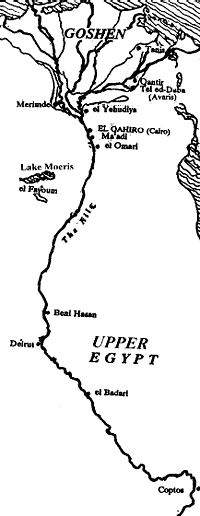
Several sites north of the ancient lake, then called Lake Moeris and now known as Lake Karoun, were explored by Gertrude Caron-Thompson and her geologist colleague Elinor Gardner in the winters of 1924-25 and 1925-26. The site Ms Gardner designated "Fayoum A" produced artifacts markedly dissimilar from those of the surrounding indigenous Saharan cultures as well as from those of Upper Egypt. The conduct of farming and husbandry underlined the unmistakable difference between the lifestyles of these peoples and those of the indigenous Africans.
Grains of emmet wheat and six-row barley filled many of the sunken silos that clustered on the high ground overlooking the village. Both of these plants are Middle Eastern domesticates and their presence in fully developed form in Fayoum A underscores the speed with which Neolithic economy moved into Egypt during the middle of the Neolithic Subpluvial (ca. 5000 B.C.). Not only Middle Eastern plants, but domesticated animals abounded in Fayoum A sites, including sheep or goat, cattle and pig.... Contacts with other lands are attested by objects like pierced marine shells from both the Mediterranean and Red Seas.5
The cultivation of the six-row barley referred to requires a large amount of water and therefore such domesticated crops could not have been developed in Upper Egypt. In contrast, an early example of this variety of barley was identified at the Mesopotamian site of Ali Kosh, where it was dated to ca. 6000 B.C.E. The grain became widely cultivated in the Land of the Twin Rivers after 5500 B.C.E. with the proliferation of irrigation systems.6
These and other equally Asiatic plants and animals that appear both in the Delta and the Fayoum through the next thousand years render unambiguous testimony to the Asiatic contribution to Egypt of the two facets of civilization, husbandry and agronomy. In an article in the journal Science, F. Wendorf compared the indigenous Paleolithic culture with that of the Fayoum A culture that displaced it. He found the differences so gross as to affirm that the new population of Asiatic peoples installed a cultural foundation in Lower Egypt on which all subsequent Egyptian civilization was based.7
El Omari; The Asiatics Move Upstream
During the Naqada period the Asiatic communities of Lower Egypt began to spread upstream (southward). Several groups of farming communities were established just below modern Cairo. In 1924 a young Egyptian mineralogist, Amin el Omari, discovered the ruins of such a community in the periphery of his home town, Helwan, about twenty-three kilometers south of Cairo. Tragically, the youthful scientist died shortly thereafter. The town, and other such villages found in the region thereafter were named after him - Omari A, B, and C, as was the culture they represented.
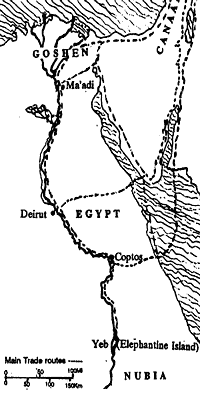
The Omari villages were urbanized centers into which was introduced an impressive array of Asian agricultural products such as sycamore dates and figs, domesticated wild sugar, emmer wheat, and an evolved type of barley. The domesticated Omari animals, like those of Fayoum A and Merimde, were Mesopotamian varieties of pigs, goats, and cows. The bones of such animals were found in abundance, along with an assortment of the bones of wild animals, birds and fish of Lower Egypt. The separate housing and facilities of the villagers, each of which was self-contained, reflect the egalitarian character of Omari life. The tools, the pottery, and the method of burial of the earlier Omari periods all resembled those of southwestern Asia and those of the other Asiatic villages to the north. Archaeologists took note of this distinct culture by referring to it as the "Deltic Tradition."
Subsequently, the Omari culture began to absorb some of the burial and other customs of the Upper Egyptians, an evolutionary cultural trend that intensified in both directions with the increase in social intercourse. Grave offerings of imported ornaments, such as stone and shell beads, begin to appear in some of the later burials. In one grave a staff was found clutched in the hand of the deceased, interpreted by some archaeologists as a symbol of authority, a symbol that was never found in earlier Asiatic graves.
Nonetheless, the social stratification that is clearly evident in the contemporary Amratian and Gerzean societies of Upper Egypt was comparatively minimal among the Omarians.8
One of the most significant discoveries was that the El Omarian as well as the Deltic communities grew fodder vetch, a crop specifically produced for the feeding of domesticated animals and especially suitable for feeding the most common Asiatic draft animal, the Asiatic donkey.
The donkey was alien to Egypt. In fact, the Egyptians had never employed pack animals during the Pre-Dynastic period. The Egyptians first laid their eyes on the braying beasts when Asiatic merchants passed through on the way to trade with the Nubians. The indigenous Egyptians were therefore long cognizant of the existence and use of draft animals. They had not, however, as yet developed an economy that required the use of "beasts of burden."
The only remains of donkeys found in Pre-dynastic Egypt were those unearthed from the ruins of the Asiatic villages.
Ma'adi: Industrial and Trade Center
A large quantity of such bones and the trappings of pack animals were conspicuous in the ruins of Ma'adi, another Asiatic community ten miles northwest of El Omari. The quantity of the relics of trade unearthed attested to Ma'adi's importance to the commercial traffic passing through.
Ma'adi flourished at a time coeval with that of the southern "Naqada" culture. The community flourished until its destruction in the Early Dynastic period. The sprawling town covered eighteen hectares. On its northern periphery extensive granaries consisting of meter-high jars were nested deep into the sandy soil, a system of storage reminiscent of that at Merimde. In addition, however, the Ma'adians employed substantial storage pits whose sides were reinforced with mud or basket-work. They were found to contain not only carbonized grain but basalt vases, carnelian beads, and other precious items. The people of Ma'adi were clearly industrially advanced. They engaged in hunting and gathering to a far lesser extent than the precedent peoples of the Delta and Fayoum. Having less wild life to draw upon, they became even more expert in agronomy and turned more importantly to crafts. The sophisticated products of the Ma'adis attest to the fact that they were accomplished artisans.
"Copper axe-head spoiled in casting and masses of copper ore indicate that copper was being processed at Ma'adi. Ma'adi is the oldest site in northern Egypt in which copper artifacts have been found."8b The axes, daggers, and other cast copper tools found in the north, and the few such tools that begin to appear in the Gerrzean sites to the south, may well have been produced at Ma'adi.
Importing was an activity which is eloquently evidenced by the donkey bones excavated from Ma'adi's ruins and is further attested to by artifacts and materials of foreign origin. Albeit Ma'adi is situated at the western end of a Wadi which leads to the copper deposits at Jebel 'Ataqa and the Sinai, it appears that the Ma'adis imported the material rather than mined it. "Ma'adi was an important entrepot handling trade between the Nile Valley, the Sinai Peninsula, and Palestine [Sic]." Much early Bronze Age "Palestinian" pottery coeval with the Pre-Dynastic period was unearthed from Ma'adi.9 These artifacts, and a variety of other evidences of imported materials amplify the impor-tance of Ma'adi as an industrial and commercial center.
The physical differences between the peoples of Pre-dynastic communities of the Delta, Fayoum and of villages like Merimbe, El Omari, and Ma'adi are even more striking than the differences in housing and technology. "The Upper Egyptian people were mostly small in stature and had long, narrow skulls, dark wavy hair, and brown skin... Skeletons found at Merimde, El Omari and Ma'adi suggest that the peoples of the Ptredynastic Delta were taller and more sturdily built than the inhabitants of Upper Egypt, and their skulls were broader. The larger, mesocephalic peoples, whose skeletons were found as far as Abydos by the time of the First Dynasty, were the Armenoid type of Western Asia,"10
The people of Ma'adi were among the communities of Asiatic peoples who were still productively active in the north at the time it was invaded and their communities destroyed. The Asiatics suffered a cruel thanks for the technology and culture they had introduced. "Ma'adi met a violent end as witnessed by widespread ash and human bones over the settlement. If so, then perhaps this was the "final solution' arranged for the heterogenous society of Ma'adi by the victorious kings of the First Dynasty."11
The Asiatic communities were ravaged, the peoples enslaved, and progress in all of Egypt virtually ceased.
Impact of Asiatic Culture on Upper Egypt
Egyptologists generally divide the late prehistorical period of Upper Egypt into two phases of the Neolithic period. The first, addressed above, took place between c. 5000 B.C.E. and c. 3500 B.C.E. During this extended period the practice of husbandry and agronomy filtered slowly down along the Nile from the Delta and the Fayoum. The following Badarian culture of Upper Egypt (after the site of el Badari) was in turn followed by what was designated as the Naqada period. (After the site of Naqada near Koptos). The Naqada period was further subdivided into two phases. The first of these was designated the Amratian culture (after el Amri near Abydos).
In the Naqada II phase, further distinguished as the Gerzean culture and dated from c. 3500 B.C.E. to c. 3170 B.C.E., the glimmerings of the Chalcolithic (Copper-Stone) Age appear in Egypt. Mesopotamian and Levantine trade coursed through Egypt not only down along the Nile, but also from the east across the desert and the Red Sea [see map, p. 4]. The name that characterized the period, "Naqada," literally means "The Golden Town," reflecting the fact that the gold of the eastern desert and that of Nubia passed through it. The traffic along these routes imprinted the passage of itinerant Asiatic merchants and their influence upon the area through which they passed.
"This essentially African [Naqada] culture might have remained static at this stage of development, as it did in the Sudan for much longer, if it had not apparently been re-animated from Western Asia, whence some significant introductions now came."12
Sun-dried mud bricks, a building material characteristic of Lower Mesopotamia, were first employed in Upper Egypt during this period. The use of a distinctly Mesopotamian device, the cylinder seal was introduced and traces of writing appeared. Their images bore a marked resemblance to those of the Land of the Twin Rivers. The pear-shaped stone mace-heads found in an earlier context in the Deltic Asiatic communities such as Merimde, replications of Mesopotamian models, appear in the south in the Gerzean period. The use of metal tools was non-existent in Upper Egypt until the latter part of the Gerzean period. A few metal pins and ornaments first appear which may well have been trade goods. Toward the end of the period a few crude, locally made copper tools do appear. The Copper-Stone Age had finally arrived.
During that same time period, the latter half of the fourth millennium before the Common Era, Mesopotamia had crossed into the Bronze Age. The peoples speaking related "Semitic" dialects were spreading out along the Fertile Crescent from the great cities along the crown of the Crescent. They moved south and east to absorb Sumer, situated strategically athwart the area where the Euphrates and the Tigris meld into the Arabian Gulf. Trade with the peoples of another great and early civilization in the Indus Valley of India reached significant proportions. Traders were likewise ranging westward and established karums, trading villages adjoining the cities of Anatolia. The flow of Asiatic traders down the Nile burgeoned. Along the way they paid tribute to the petty princes along the cliff-lined banks for the right of passage.
Conquest of Lower Egypt
A graphic depiction of the manner in which the Upper Egyptians gained and maintained power is supplied by the famous Egyptian "Narmer Palette," cited by archaeologists as one of the earliest and by far the most definitive record of events that transformed Egyptian history.
On one side of the palette, the king, Namer, is proudly wearing the White Crown of Upper Egypt and is portrayed in the act of bashing in the head of a resistant northerner. The Semitic features of this and the other slaughtered enemies below are clearly evident.
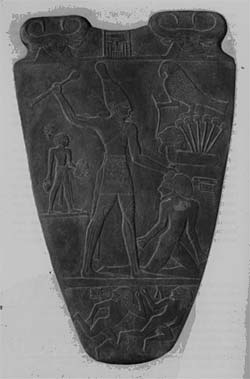
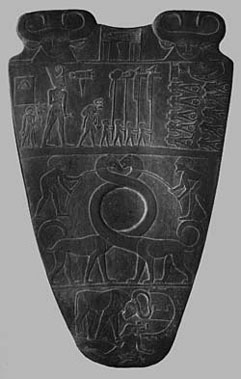
On the reverse side the scene shifts in time to the end of a campaign, and the Egyptian king is seen in procession from a fort or building. It is a Sumerian pictograph of URU, meaning "guarded place," that is, a walled fortified area. The inscriptions near the head of the attendant behind the king are likewise rendered in Sumerian, identifying him as a "runner forth," designating his function. The king, now wearing the Red Crown of Lower Egypt, is calmly gazing upon rows of beheaded enemies (their heads are nested conveniently between their legs).
The third register depicts the entwined necks of two feline serpopods, a design found in Mesopotamian seals and carvings. They are typically Elamite or western Asiatic. Other details likewise stem from a Sumerian pictographic origin.13
The remarkable aspect of the Narmer Palette is that it employs Sumerian words and pictographs, a clear indication of the root from which Egyptian writing stemmed. The Palette became typical of the self-aggrandizing iconography of future pharoahs, the proud possessions of museums and collectors. The grandiose monuments erected to themselves by the succession of Egyptian kings are taken as definitive markers of an advanced society. The dearth of such vainglorious art and architecture in the relatively egalitarian Semitic societies led historians to assume a low cultural level of those societies. The agronomic and technological advances wrought by these precedent cultures are given little weight in the scale of civilization. The fact that the great monuments, palaces, rich palatial accouterments, and the iconography so prominently displayed in museums were made possible by the technological advances of the conquered peoples are given no account.
Large numbers of artists and craftsmen were indentured or enslaved to produce luxury goods in metal, wood, and stone for the royal Egyptian courts and hierarchy. "These craftsmen... evolved a coherent style and established artistic canons that were to remain an integral part of the elite culture of Ancient Egypt."14 The abundance of food produced in Lower Egypt was traded for Canaanite goods. Additional material goods were seized by the early pharaohs in raids upon their neighbors. Great quantities of Canaanite pottery vessels of the Early Bronze Age have been extricated from the tombs of the First Dynasty.
Other aggressive nomarchs (Ka and Aha), overlords of local principalities or nomes along the Nile, are mentioned as donning the White or Red Crowns. Finally, we are told, a Theban ruler appears, Menes, who invaded the North, took firm control and initiated the first All-Egyptian Dynasty. Whether Menes, Narmer, and Scorpion are in fact one and the same, or whether one or the other of the Upper Egypt warlords was the actual conqueror of the Asiatic communities and initiator of the Dynastic era remains a mystery and a matter of scholarly debate. What is evident is that the villages of Lower Egypt were transformed from members of a loosely organized society in which autonomous chieftains and "carpetbagging" merchants played the most significant roles, to one of vassals under the centralized control of an imperial king.
The glory which modern-day Egyptologists (and their credulous disciples) have attributed to the "unification" of Egypt is belied by the record of the dire consequences of the imposition of southern rule upon what was until then a flourishing and developing economy. Manfred Bietak, the renowned excavator in the Delta region, was struck by finding that the glory attributed to the early dynasties was but an illusory facade, and that, in fact,
Little attention is being paid by many current archaeologists and historians to the civilization that was overtaken by the petty princes of Upper Egypt. In place of delving further into the evidence of that seminal civilization, they strive mightily to prove that Egyptian civilization arose by its own bootstraps. In this they are like the Egyptians, who believed that scarabs were miraculously created in the dung heaps in which they were found.
Since the advent of the State of Israel in 1948 the issue has assumed over-riding political overtones. It is no longer merely an issue of national pride. The Egyptian and Islamic worlds strive to lay an archaeological foundation beneath their geopolitics. As a result, a cultural curtain has been dropped between the two founts of Egyptian civilization, Asiatic and autochthonous. It is now "politically correct" to give credence only to facts that support the indigenous origin of Egyptian culture and to ignore or negate contradictory evidence.
In 1995 for example, a tableau of some figures scratched into limestone dating to the time of the legendary King Scorpion were found by Dr.. John Coleman Darnell and his wife, Dr. Deborah Darnell [see p. 8]. The figures were rendered in a primitive fashion, no different than those of similar representations by pre-literate societies the world
some dating back 10,000 years or more. The single fact that included among the figures were what appear to be a scorpion and a falcon, led to the conjecture that this might be a verification of the legend of King Scorpion. In addition, the interpretation was stretched to an inference that here was the precursor of a written language predating that of Sumeria.
Such flights of fancy are being seriously considered by a number of Egyptologists despite contradictory cultural and technological evidence. The great technological gap between the two cultures, the Mesopotamian, already in the Bronze Age and the Upper Egyptian just emerging from the Stone Age, is overlooked. The comparison of the primitive elements of Egyptian society with the populous Asiatic cities, the agronomic expertise of their peoples, the extensive trade activity the Asiatics carried on from India to Anatolia to Nubia was not taken into account. The fact that the tablet was found at the convergence of trade routes that had been in use by non-Egyptian traders for many centuries before the establishment of the First Egyptian Dynasty, was likewise ignored. The weight given to such tenuous iconography belies the fact that the origin of pictographic writing in Egypt already had been accounted for.
Pictographic writing in Sumer, far more sophisticated than that of the limestone fragments found in Egypt dates back to between 3500-3400 B.C.E. of the Uruk Period. At that early date, when the population of Lower Egypt was as yet confined to tiny enclaves, two already sizable Uruk towns coalesced to form a city whose walls enclosed 450 hectares in which as many as 50,000 people could have been housed. A large trove of clay tablets dating to shortly after 3300 B.C.E. was found, inscribed with than 700 signs. They registered the transfer of commodities such as grain, beer, and livestock as well as lists used by scribes learning how to write. The significance of these massive business and schooling records is that the system of writing must have had a long prior development period, probably of several hundred years. That the single primitive Egyptian tableau, even if it does date to the same period, can be held to be the precursor of the Sumerian script is clearly stretching credibility beyond its limit.
During the subsequent Jemdet Nasr Period, contemporary with that of the Egyptian tableau, the pictographs became more symbolic of motions and ideas. H. J. Kantor noted that "The first attempts at a pictographic system of writing [in Egypt] has been traced by some scholars to the Jemdet culture [of Mesopotamia]."16 Sumerian writing soon passed on to the logographic phase, in which the drawings became stylistic symbols for an object or an idea. This interim phase. was clearly a precursor of the cuneiform characters (phonograms) that followed, and eventually to the Aleph-bethic system.
The Egyptian passage from one phase to another reflected this process, but at an infinitely slower pace. Only crude phonograms were ever employed, and the ancient Egyptians never arrived at an aleph-bethic system.
Early Consensus about the Semitic Foundation of Egyptian Civilization
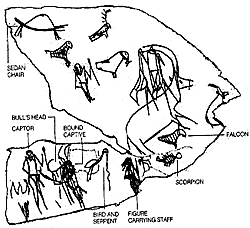
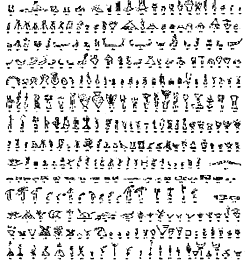
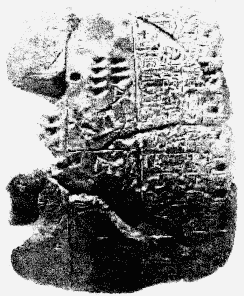
Through the mid-twentieth century the Asiatic origin of Egyptian technology gained affirmation from an ever-growing corpus of new discoveries. The flush of the discovery of the well-preserved desert Egyptian culture and its spectacular artifacts was mitigated by an understanding that the less well-preserved Mesopotamian cultures were more ancient and more advanced than that of the Egyptians and worthy of examining for a better understanding of the evolution of civilization. The rush for unearthing exotic, museum-worthy Egyptian artifacts gave way to soberer and more scientific archaeological disciplines. Many scholars came to appreciate the validity of Petrie's opinions and the value of Breasted's observations. Evidence was continuously coming to light that Asiatic influence was particularly potent during two periods: the Pre-Dynastic period, and again under the six Asiatic kings during two centuries of the "Second Intermediate Period" (15th - 13th centuries B.C.E. - the subject of the subsequent Fact Paper).
Will Durant, (Our Oriental Heritage, 1954) summarized the consensus of the archaeologists about cultural leap made in Egypt under the Semitic kings, noting that Semitic influence can, in fact, be traced much further back: "The further back we trace the Egyptian language the more affinities it reveals with the Semitic tongues of the Near East. The pictographic writings of the pre-dynastic Egyptians seems to have come in from Sumeria."17
Percy Handcock, (Mesopotamian Archaeology, 1963), confirmed Breasted's observations: "The Semites swept over Egypt and the north coast of Africa, impressing their indelible and unmistakable stamp upon the foundation-structure of the Egyptian and Libyan languages.18
John A Wilson (The Culture of Ancient Egypt. 1963) agreed: "At this point there was an artistic, intellectual, and technical fructification from Babylonia, and Egypt made a great spurt toward history."19
W. Wendorf (Egyptian Prehistory, Some New Concepts, 1969) summed up by stating that the early pre-Dynastic cultures record the arrival of a new population in Egypt, who brought with them the cultural base from which Egyptian civilization was to develop."20
Sir Alan Gardner, (Egypt of the Pharoahs, 1979), concurred: "Many affinities (of the Egyptian language) with the Hamitic and in particular with the Berber dialects have been found... on the other hand the relationship with Semitic (Hebrew, Arabic) is equally unmistakable.21
It was then recognized that Egyptian culture and economy was given a second and most potent thrust forward during a Semitic influx in the so-called Second Intermediate Period. During the two centuries of that period under the rule of six Asiatic ("Hyksos") chieftains, Egypt was boosted from the Chalcolithic into the Bronze Age.
William Hayes, in compiling "A background for the Study of Egyptian Antiquities in the Metropolitan Museum of Art," concluded that: "Over the Hyksos Bridge there flowed into the Nile Valley in unprecedented quantity new blood strains, new religious and philosophical concepts, and new artistic styles and media, as well as epoch-making innovations of a more practical nature."22
That remarkable record is the subject of the Fact Paper 10-II: Egypt and the Semites; The Second Intermediate Period.
Exclusionary Politics and Science
The realization by Egyptologists of Semitic seminality produced a bizarre result. The search for pre-dynastic evidence virtually ceased! Dr. Trigger, of the McGill Department of Anthropology, pondered upon this peculiar circumstance: "The conviction that Egypt was not an important center of plant and animal domestication and a consequence shift of interest to south-western Asia are, in part, responsible for the dearth of field-work on Pre-Dynastic sites in recent years."23
On the one hand, sites such as el Yehudiya ("Jew-Town" - see map on page 3) were abandoned, left for scavengers to ravage its remaining artifacts. On the other hand, attention was focused on every minutia of Egyptian origin to bolster the theory of autochthonous cultural development in Egypt.
A hiatus in Egyptological research also resulted from a lack of attention to the life of ordinary people, a defect of archaeological research that has only recently been addressed. The Asiatic communities were farmers, artisans and traders, headed by local chieftains. No massive monuments were erected in their villages for future tourists to gawk at, no hedonistic sculptures were produced for museums to vie over, nor were the chieftains entombed with golden artifacts for future collectors to salivate over.
"It is no wonder that the present state of studies of ancient Egyptian civilization is enormously one-sided," declared Manfred Bietak, excavator of Qantir, the site on which the biblical city of Avaris was identified. "In Egypt, temple sites and cemeteries have been chosen as objects of excavation and study because they yield more museum objects and, with their imposing architecture and representations of fine arts, are far more likely to impress the trustees of institutions than the decayed mud-brick architecture of town sites with their tons of potsherds."24
History, it was wisely said, repeats itself. After 1500 years of periods of stagnation another Semitic influx had a revolutionary impact upon the culture of Egypt. Their contribution is being likewise ignored or denigrated.
The story of how the Semites brought the Bronze Age to Egypt follows.
Notes
1: James Henry Breasted, A History of Egypt, 1905, reprint, Bantam, NY 1964, 4,20.
2: Michael A. Hoffman, Egypt Before the Pharaohs London, 1980, 27.
3: Hoffman, Ibid, 181.
4: Hoffman, Ibid, 169.
5: Hoffman, Ibid, 186, 189.
6: G.E. Wright, "The Archaeology of Palestine from the Neolithic through the Middle Bronze Age," Journal of the American Oriental Society 91, (1971) 276-293.
7: Wenderf et al, Egyptian Prehistory; Some New Concepts" Science, 1969, 1161-1171.
8: Hoffman, Ibid., 196.
8b: Trigger et al, Ibid., 25-26.
9: Trigger et all citing Kantor, "Relative Chronology of Egypt," Ibid., 9.
10: D.E. Derry, "The Dynastic Race in Egypt," Journal of Egyptian Archaeology, 42 (1956), 42.
11: .Hoffman, Ibid., 214.
12: Cyril Aldred, The Egyptians, 1961, London 77.
13: Louis A. Waddell, Egyptian Civilization, Its Sumerian Origin & Real Chronology and Sumerian Origin of Egyptian Hieroglyphs, 1933, 85-91.
14: Trigger et al, Ibid., 60.
15: Bietak, Ibid., 129.
16: H. J. Kantor, "The Relative Chronology of Egypt and its Foreign Correlations before the Bronze Age," in Chronologies in Old World Archaeology, ed. R. Ehrlich Un. Of Chicago Press, 1965, 1-46.
17: Will Durant, Our Oriental Heritage, New York 1954, 135.
18: Percy S. P. Handcock, Mesopotamian Archaeology, New York, 1963, 5.
19: John A. Wilson, The Culture of Ancient Egypt, ( Un. Of Chicago Press, 1963, 39.
20: F. Wendorf et al, "Egyptian Prehistory, Some New Concepts," Science, 1969. 1161-1171.
21: Sir Alan Gardner, Egypt of the Pharoahs, Oxford Un. Press, 1979, 19.
22: William C. Hayes, The Scepter of Egypt, Part 2: The Hyksos Period and the New Kingdom (1675-1080 B.C.), Metropolitan Museum of Art, 1968, 4.
23: RosalieDavid, The Ancient Egyptians, London, 1982, 12.
24: Manfred Bietak, "Urban Archaeology and the 'Town Problem' in Ancient Egypt, Egyptology, 1919, 97.
